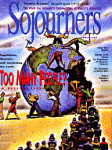What can be eaten for breakfast, lunch, or dinner; is grown in all 50 states; and had a war named after it? The potato of course. (The 1778-79 War of the Bavarian Succession was nicknamed "The Potato War.") The Incas of Peru, who cultivated hundreds of ancient potato varieties in terraced highlands, measured units of time by how long it took a potato to cook.
This marvelous crop provides more calories per acre than any grain or vegetable. While potatoes can be grown in a dazzling array of shapes, colors, and sizes, these days most of us rely on the russet Burbank, the white Katahdin, and several red varieties. "Yukon Gold" is gaining favor rapidly, probably because its creamy yellow flesh gives the impression of having lots of butter when it’s served.
In Texas, red potatoes are the passion, fittingly planted on Valentine’s Day and harvested in May. That is, if the weather permits. This year a capricious heavy rain, combined with 80 degree temperatures, doomed my farm’s potato crop to a rotting morass. So I am somewhat forlornly sitting inside today writing about potatoes instead of digging them.
I admit I was really looking forward to "new potato" season. I had the menu all planned out—boiled potatoes with butter and parsley, cream of potato soup, leftover potatoes fried for breakfast, potato salad, and shepherd’s pie. And I wasn’t the only one. Our neighbors were over twice last week to see if the potatoes were dug yet. Elderly family members who used to have farms of their own have been reminiscing about past potato harvests and lamenting the fact that senior nutrition centers these days don’t serve enough potatoes.
I can’t say as I’ve ever met anyone who doesn’t like to eat potatoes. I’ve met many who claim they would gladly eat them everyday. Whether a boxty (a thick Irish pancake made from mashed or shredded potatoes), a gnocchi (an Italian potato dumpling), a knish (a Jewish pastry), a scalloped potato casserole (an American potluck classic), or a big baked potato, this food provides much pleasure to the eater.
And the potato is no slough when it comes to nutrition: In a medium baker, there are 93 calories, 2.6 grams of protein, 10 milligrams calcium, 12 grams carbohydrate, .1 gram fat, and 503 milligrams potassium (more potassium than a banana).
For now, I guess I’ll fish out the remnant bag of grocery store russets from under the counter, scrub off the sprouts, and cut out the brown spots. I’m not complaining, mind you—I’m thankful potatoes store so well, allowing for year-round consumption. But the thought of those delicate-skinned, creamy-fleshed, dusky-tasting new potatoes will continue to haunt me....
Sunday Potato Pancakes
Because I am always trying to find ways to make breakfast a hearty meal, this pancake recipe has become a great favorite, and not just on Sundays!
• 2 cups mashed potatoes (3 medium potatoes yield about 2 cups)
• 1 1/2 cups flour, white or whole wheat
• 2 1/2 tsp. baking powder
• 2 Tbls. sugar
• 1/2 tsp. salt (unless mashed potatoes are already salted)
• 3 Tbls. oil
• 1 egg
• 1 1/2 cups milk
Add egg, oil, and milk to the mashed potatoes. Mix well. Sprinkle in half the flour, along with baking powder, sugar, and salt. Stir thoroughly. Add remaining flour, stirring only briefly to keep gluten strands from forming and making the pancakes tough. You may need to add more milk to give the batter the proper consistency for frying.
Pan fry as with any other kind of pancake, over medium heat, preferably in a well-seasoned cast-iron skillet.
Makes eight large pancakes.

Got something to say about what you're reading? We value your feedback!